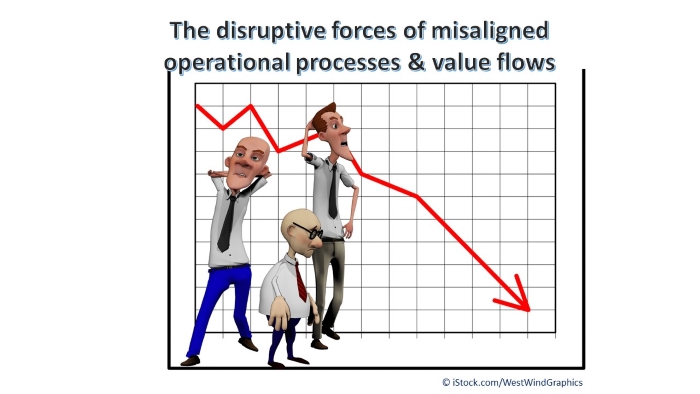The disruptive forces of misaligned operational processes & value flows - What follows
What follows
The far reaching consequences of misalignment between Operations and Finance & Controlling have been felt at all stages of major business transformation initiatives across many industries. Areas impacted range from process design and systems testing through to hyper-care and running the daily business. To demonstrate this, we revert to some use cases from major business transformation projects, and show how things went wrong. The examples demonstrate how an apparently isolated problem can have impacts far beyond the radar of those responsible for implementing and championing the change.
Case 1: Misalignment between procurement, logistics, and accounting impacts system testing
Because involvement of local tax and finance departments into the project happened too late, the entire procurement process for certain materials had to be redesigned during testing phase. While making up for this, realignment across all related streams resulted in extra effort and a high potential risk of delays in go-live dates.

Case 2: Misalignment between production, procurement, and accounting during process design phase impacts process execution during hypercare
The weighting step that is executed by a subcontractor was part of a recipe. During the process design, the production team only focused on processes relevant for core business. Therefore, the weighting process was not designed and consequently not configured in the ERP system. There was no account assignment. This problem was noticed during hypercare when the process had to be executed. As a result, no sales order could be created. Compounding the problem was the fact that there was no process concept. The whole life cycle of the process had to be adjusted within a productive environment.
Case 3: Misalignment between sales and accounting during process design phase impacts process execution during daily business
Sales of products to employees where not foreseen, and consequently not discussed during the process design phase with accounting. Sales typically only focused on core business. In the newly implemented productive ERP system, it was unclear how to execute the transaction “sales of products to employee” and how to invoice return for production unit and cost for sales shop.
Case 4: Misalignment between logistics, procurement, and accounting during process design phase impacts process execution during daily business
Assignment of logistic expenses to the right positions are critical from an accounting point of view. These involve cost of distributors. Incorrect valuation of cost of sales, cost of production, and time of sales recognition poses a compliance risk involving tax authorities. This can also have COPA impacts (COGS vs Production Costs), causing dissatisfactions of responsible executives in case of variable salaries. During a business transformation project, there was a lack of knowledge on two sides. Logistics was unaware about the fact that such regulation exists, and accounting unaware about different type of contracts SCM had with its business partners. This problem was noticed during daily business, i.e. after go-live and hypercare.
